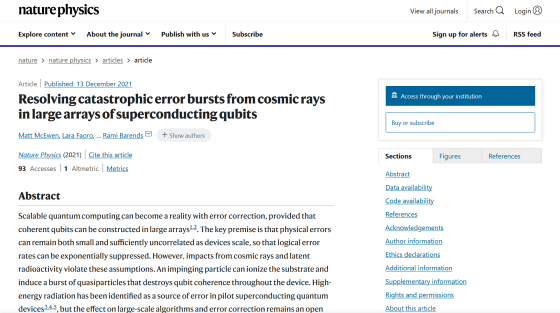Research results that 'cosmic rays' cause serious errors in quantum computers

Resolving catastrophic error bursts from cosmic rays in large arrays of superconducting qubits | Nature Physics
https://www.nature.com/articles/s41567-021-01432-8

A potential hangup for quantum computing: Cosmic rays | Ars Technica
https://arstechnica.com/science/2021/12/cosmic-rays-can-swamp-error-correction-on-quantum-processors/
Conventional computers use bits that can only take '0' or '1' states, but quantum computers use qubits that can take both '0' and '1' states by superposition of quanta. This makes it possible to perform ultra-high-speed calculations. However, there is a problem that errors are likely to occur in quantum computers because qubits deviate from the intended state due to various environmental factors.
The method to solve this problem is quantum error correction , in which error detection and correction in a conventional computer is performed on a quantum computer. It is important to correct qubit errors in order to ensure that the calculation results by the quantum computer are correct.
However, when Google's research team was testing quantum error correction with a quantum processor, they faced a strange phenomenon in which error correction failed sporadically. As a result of investigating the cause, it seems that the error that occurs in the qubit is caused by 'cosmic rays'.

Cosmic rays, which are high-energy radiation, are known to cause errors in classical computers that rely on the movement and storage of electric charges, but the mechanism of influence is different from that of quantum computers. When cosmic rays collide with a qubit, the vibrational energy behaves as
In fact, the research team observes whether cosmic ray-derived errors occur in qubits by selecting 26 qubits on the processor, setting them to a single quantum state, and leaving the processor idle. Did. As a result, the typical error rate of qubits in 100 microseconds was 4 out of 26, but when a cosmic ray happened to hit, the error rate jumped to 24 out of 26. Also, when we traced the state of the qubits throughout the processor, the error, which was initially limited to qubits near where the cosmic rays collided, became farther away from the qubits as the phonons spread throughout the processor. But it seems that the error rate has increased.
Quantum error correction detects errors that occur in individual qubits by setting adjacent qubit groups as a single logical unit. However, the research team says that the phonons generated by the collision of cosmic rays behave as quasiparticles, which simultaneously confuses the states of all adjacent qubits and hinders quantum error correction.
Also, if cosmic ray collisions occur rarely, discard the calculation result including the error and perform the calculation again to obtain the correct result for the time being. However, even the relatively small quantum processor used in the experiment experienced an error every 10 minutes, so the frequency of cosmic ray collisions is too high for a quantum computer to perform calculations that may take several hours. It's too much.

Unfortunately, at the time of writing, no method has been developed to mitigate the effects of cosmic rays on quantum computers, but the research team points out that astronomers face similar problems in designing image hardware. .. Astronomers are working on improving the hardware to curb the spread of phonons, and similar solutions could be diverted to quantum computers.
Related Posts:
in Science, Posted by log1h_ik







